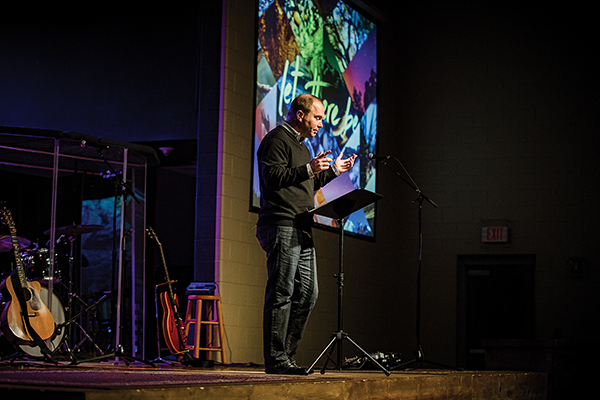
While many church plants are simply trying to make it week to week, Shoreline Church in Knoxville, Tenn., leveraged new ways of thinking to eliminate the guesswork for funding ministry.
Through data & analytics, Shoreline developed a plan that resulted in a $653,000 one-day offering. It also laid the foundation for a culture of generosity.
By RaeAnn Slaybaugh
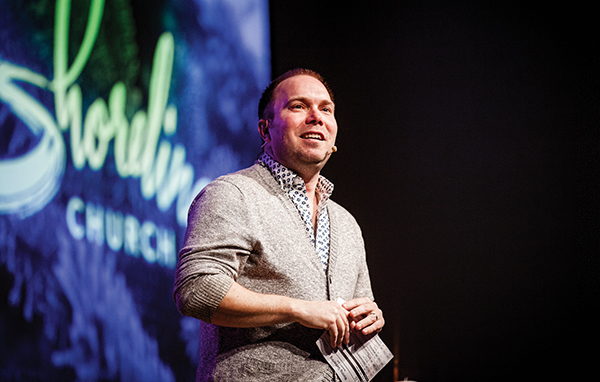 Rapid growth created unique challenges for Shoreline
Rapid growth created unique challenges for Shoreline
The church’s story begins with the leadership journey of Lead Pastor Jason Hayes.
Hayes was on staff at sending church Long Hollow Baptist in Hendersonville, Tenn., a suburb of Nashville, when he joined LifeWay Christian Resources as a national ministry specialist. In this new role, he spoke at many churches and conferences and provided training and consultation to churches; however, he remained involved in leadership at Long Hollow.
For Hayes, these two experiences bred a passion for the Gospel and the community — and, in turn, for planting a church. He and his wife, Carrie, reached out to the lead pastor at Long Hollow to discuss transitioning away from Nashville to plant a new church in Knoxville.
In 2011, Shoreline was born. It started small, with members meeting in various facilities — Hayes’ home, a marina clubhouse, a dentist’s office.
Within five months, the church hosted its first Sunday morning gathering in a leased space located within one mile of the families and college students it hoped to reach.
Today, Shoreline owns that facility, and has sent 70 of its people to the other side of town to plant another church. It is working towards a $1.5-million budget for 2017.
Overcoming the challenges of church planting required a new way of thinking
Hayes had a vision for Shoreline — a hospital for (and by) the hurting. By all accounts, this vision and the growth of Shoreline were enormous; but, like many church plants, it was initially understaffed. Fortunately, the core group was eager and committed — though not necessarily experienced in ministry development.
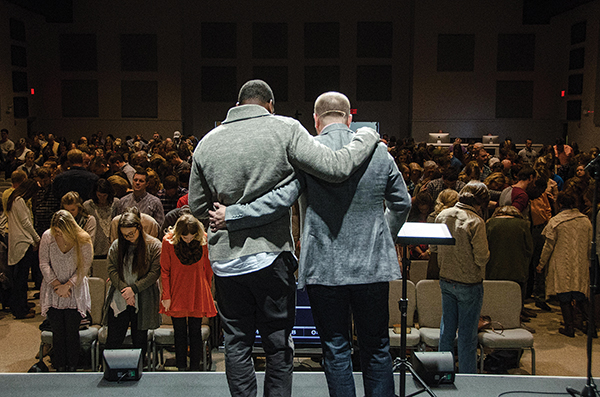 “We weren’t interested in ‘swapping sheep,’” Hayes explains. Despite a number of contacts in the Knoxville area who would happily have come onboard, Hayes urged them to stay and serve their churches.
“We weren’t interested in ‘swapping sheep,’” Hayes explains. Despite a number of contacts in the Knoxville area who would happily have come onboard, Hayes urged them to stay and serve their churches.
“Candidly, I remember one early morning when I said, ‘Lord, You’ve answered our prayers, but I could probably use a few more doctors if you’re going to keep bringing all these patients,’” he laughs.
“They came, and they ended up being remarkable people being raised up through discipleship, transitioning into a new season.”
For the first half of Shoreline’s life, the Church relied heavily on highly streamlined groups of volunteers. Today, it has a staff of six, many of whom have joined in recent days.
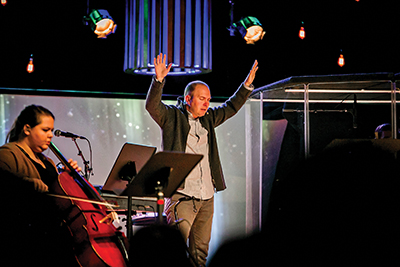 With his focus set solidly on caring for the people they already had, owning a facility wasn’t an immediate priority. “In fact, in our earliest days, not owning a facility was very healthy,” Hayes says. “People were committing to a mission and a vision. They were buying into our relational community as opposed to a building, a location, or the conveniences that come with a certain address.”
With his focus set solidly on caring for the people they already had, owning a facility wasn’t an immediate priority. “In fact, in our earliest days, not owning a facility was very healthy,” Hayes says. “People were committing to a mission and a vision. They were buying into our relational community as opposed to a building, a location, or the conveniences that come with a certain address.”
So, he and his team waited until the time felt right for their next step — purchasing a facility..
It’s worth noting that the building in which Shoreline was meeting (and now looking to buy) was originally built by a church plant that dissolved several years ago. For some pastors, this might have been a physical reminder that many church plants don’t, in fact, make it.
But Hayes was intent on looking at — and doing — things differently at Shoreline.
The dissolved church plant’s sending church had taken ownership of the property and “they looked at this as an opportunity to bless us,” Hayes says. “And we knew that [purchasing the building] could also provide them with funds that could be used towards their ministries. It was a win-win.”
It certainly was … but not immediately.
 A multipurpose space would need to be transformed into the worship center, its basketball hoops and flooring panels removed and significant wear-and-tear fixed. In the parking lot, traffic flow needed to be modified to send everyone to a few different entrances (including a kids’ entrance) instead of just one point of entry. The lobby needed to be opened up to accommodate a larger — and growing — volume of people.
A multipurpose space would need to be transformed into the worship center, its basketball hoops and flooring panels removed and significant wear-and-tear fixed. In the parking lot, traffic flow needed to be modified to send everyone to a few different entrances (including a kids’ entrance) instead of just one point of entry. The lobby needed to be opened up to accommodate a larger — and growing — volume of people.
Of course, all of these renovations (not to mention ongoing maintenance) came with a price tag.
As Hayes looked for ways to lead his church through the changes, challenges and opportunities they faced, he knew he needed to think differently about finances. In a word, the focus turned to generosity — how to build it into the church culture and implement strategies and processes that would sustain it.
In Spring 2015, he called upon Derek Hazelet, Senior Vice President at Dallas-based RSI, a long-time friend and colleague from Long Hollow, to help him navigate the challenges and opportunities Shoreline was facing, using RSI’s approach to analytics & modeling. Together, they began to streamline processes and organize data in a way that painted a clear, complete picture for where the church stood at the time and how it could create a culture of generosity to reach the vision God had given Jason and the team at Shoreline.
The initial work led to a successful one-day offering that raised more than $650,000.
Getting from there to here required an ambitious goal
When all factors were considered, a $650,000 one-day giving goal was set — actually $1 million, but the church was fortunate enough to have set aside $350,000 in savings, thanks to the generosity of the congregation and effective stewardship by the
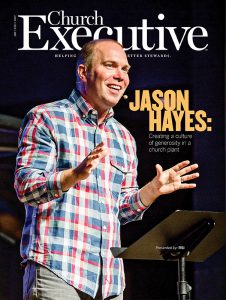
staff.
“That was the amount we felt comfortable with,” Hayes says. “It would allow us to close on the facility, put some money back into our savings, and accomplish some of the renovations we talked about.”
Though it was an ambitious amount, Hazelet wasn’t worried. Based on Shoreline’s lean operations and strong lay leadership, he knew that whatever vision the Lord had for the church would be fulfilled. This strong shared vision, a body of believers willing to share their resources to fulfill that vision, and a somewhat immediate need to have funds in hand to start moving toward it, were what made a one-day offering the best option for Shoreline.
The results were nothing short of amazing: Shoreline exceeded its goal with a total one-day collection of $653,000 in cash and checks, on hand and ready for deposit.
While this massively successful single-day offering is certainly worth examining, it’s equally important to look at the relationships that drove those results — between the church and its leaders, and between Shoreline and RSI.
“What I’ve loved is that it hasn’t been about a number,” Hayes says of the church’s partnership with RSI. “It’s been about the mission of Shoreline.”
Hazelet agrees and add: “We’ve needed to be fluid and flexible enough to move as the spirit moved.”
With like minds, Hayes and Hazelet then sat down to think hard about the mission, and then craft next steps that aligned with it.
How data & analytics eliminated the guesswork for reaching the goal
According to Hayes, Shoreline’s people supported the offering in a big way because it was immediate and compelling. “It was a ‘fish-or-cut bait’ situation regarding the building we were in,” he says. “Either we were going to be able to purchase the facility and make it our permanent home, or we would fail. In the midst of all the growth that was happening, we didn’t want to spend 12 months figuring out the next steps.”
For his part, Hazelet cites another absolutely critical driver of growth and generosity at Shoreline: Hayes himself.
“Jason can’t and wouldn’t say it, but he really has an incredible leadership gift,” Hazelet says. “He’s able to channel God’s vision for the church in a compelling way — that’s the word he used. And it’s exactly right.”
With most important piece of the puzzle in place — spiritual leadership — Hayes and Hazelet had turned once again to data & analytics to develop the strategy leading up to the hugely successful one-day offering. SmartDATA uncovered three main areas of opportunity that were likely to (and did) drive a successful outcome, while continuing to sustain a culture of generosity at Shoreline.
#1: Developing an initial focus on financial leaders. Like many senior pastors, Hayes chooses not to apprise himself of how much individual members or families give to the church. Even so, SmartDATA enables his resource team, along with support from Hazelet — who has experience and insight into details about raising up financial leaders — to assemble strategic gatherings in support of the vision. While Hayes doesn’t know who the largest donors in the room are, by virtue of those individuals being present, he does know they’ve been faithful givers.
This approach lets Hayes not only see (and celebrate) those individuals who have bought into the mission, but cast that vision more clearly and shepherd those people better in support of it.
This same data can help the resource team identify people with greater capacity and potential for generosity, and prioritize those conversations for Hayes. “This means Jason can allow himself to not know some specifics and keep the integrity of this commitment,” Hazelet explains. “But, it also allows us to cultivate the major gifts which, frankly, every church relies on.”
#2: Examining giving through the lens of assimilation.” Often, churches let a giving relationship happen organically. Even so, it’s worth examining that relationship from — to use non-profit nomenclature — invitation to acquisition as part of the discipleship process.
“One thing we wholeheartedly believe at RSI is that giving is spiritual before it’s financial,” Hazelet says. “Being generous is part of discipleship growth. Based on the insights uncovered through SmartDATA, we were able to evaluate the relationship between the areas of assimilation and generosity and ask, Are we making the right connections for people? Are we helping them through the discipleship journey? How can we improve to help them make the connection between generosity and discipleship?”
This ability to measure against performance is essential, he adds. “There’s an expectation of creating a culture of generosity beyond a one-day offering, capital campaign, specific funding or a specific project. It really is about engagement.”
#3: Digging beyond the surface to identify the gaps. “Most church leaders pay attention to metrics like how much people give or how many people are giving. But when you start to dig in to how often people are giving, it gives you a picture of how the process is performing,” Hazelet explains. “We might be casting vision, but are we connecting vision with the resources it takes to fulfill that vision in the giver’s mind?”
Hayes agrees, noting that SmartDATA also enables the church to think critically about its communication efforts around giving options: “We can ask, How many of our givers are giving online? Are we / should we be giving as much attention to online options as passing the bucket on Sunday?” Such data enables him and his team to be more efficient and better serve Shoreline’s people.
This streamlined, holistic approach to ministry and creating a culture of generosity has fundamentally changed the way Hayes thinks about funding ministry and making ministry decisions.
Prior to SmartDATA integration, Shoreline had 21 independent systems in place to manage member data, communications, finances and more — not uncommon for any church, as Hazelet points out. “But you wake up one day and say, ‘These systems aren’t communicating.’
Hayes agrees: “What Derek and his team have helped us do is bring them all into relationship with one another. That has enabled us to know our people better.”
Today, a better, more holistic ministry is in place at Shoreline, driven by comprehensive and cohesive data & analytics.
“Our goal is to know and care for our people,” Hayes explains. “That includes giving them easy opportunities to engage the mission of the church, financially. By building into the church’s culture a constant seeding of God’s vision, it doesn’t feel like it requires a constant ask; instead, it’s establishing a constant motivation.”
Looking to 2017 … and beyond
Hayes is often asked if he expected Shoreline to grow so rapidly.
“Of course, we’re not responsible for the Lord’s blessings; they’re not based on our merit or our achievement,” he points out. “That said, we do have confidence, and that’s based on the Lord’s continued provision for us every step along the way.”
Moving into the New Year, Hayes and his team have an ambitious vision for their ministry. They are training up leaders to plant more churches. They’re adding staff. They’re developing new ministries. They’re reaching people they haven’t reached before and growing ministries on the verge of remarkable steps in evangelism.
With RSI’s partnership, they’re continuing to build a culture of generosity to fuel this growth. They are continuing to leverage SmartDATA to discover areas in which they can enhance the discipleship process, grow their culture of generosity, and better connect people to the tangible impact that is being made through their gifts.
This represents a microcosm of a larger posture Shoreline is embracing as it moves into 2017: People are giving, but they’re giving because they know their gifts are being used for the glory of God and for the expansion of the kingdom of God.
“We continue to lean on RSI and to lean into whatever the Lord is leading us to accomplish in the year ahead,” Hayes says. “Our people have been motivated, but we’re continuing to equip them better. We’re believing in and preparing for the harvests in the year ahead. We need resources to do that — and we believe that the insights discovered through the analytics we have at our disposal provide a clearer line of sight for reaching that vision.”
QUICK FACTS ABOUT SHORELINE CHURCH
Year Established: 2012
Location: Knoxville, Tenn.
Number of staff (full- and part-time): 6, plus 2 others
in a residency program
Combined weekend attendance: 600-700
2016 budget: $1.25 million


